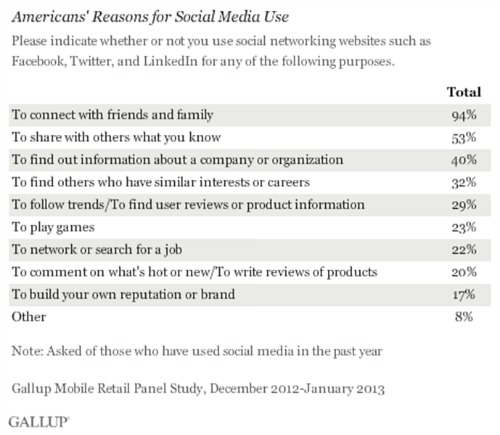
Murky research collided with lazy journalism last week to create a torrent of #socialmedia + #advertising = #fail link bait. Headlines in publications generally deemed respectable, and journalistically responsible, heralded the end of social media marketing.
“Social Media Fail to Live Up to Early Marketing Hype” trumpeted The Wall Street Journal. “This Is the New Stat Facebook Should Be Worrying About,” tsk-tsked Time. “Tweets, Likes, and Shares Don’t Make Us Buy Stuff, Americans Say,” echoed Bloomberg Businessweek. “Advertising On Facebook And Twitter Barely Even Works” came from Business Insider, and most pithily, Valleywag added, “Social Media Ads Don’t Do Shit.”
The root of this social-media-don’t-work brouhaha was a Gallup report entitled “The State of the American Consumer.” It professed that 62 percent of U.S. consumers do not believe the major social networking platforms: Facebook, Twitter, LinkedIn, and Google+, affect their purchase decisions. Additionally, Gallup claims 48 percent of Millennial shoppers are uninfluenced by social media when it comes to buying stuff.
So much for the $5.1 billion advertisers spent on social advertising last year (not to mention billions more on social media marketing programs).
The lone voice of sanity in the media was a well-reported piece in Adweek, pointing out that not only is Gallup using data from late 2012 to make this dubious point, but worse, the data are self reported. No brand or agency would ever in a million years rely on self-reported data to assess or measure ad effectiveness. Self-reported data are near-worthless.
Google the term, in fact, and you’ll come up with results such as: “Self-reported studies have validity problems” and “notoriously unreliable.”
Moreover, as Adweek pointed out in a long voice-of-reason article on the topic (disclosure: I’m quoted), Gallup’s data were collected close to two years ago — a near eternity in internet time, and to top that, some respondents were polled by snail mail, a strange channel indeed to select for research on digital influence.
Looking beyond the dubious self-reported data, the digital equivalent of saying, “Sure, I saw a commercial on TV but didn’t buy the product so advertising doesn’t work,” some of the questions Gallup posed are strong indicators that social channels are indeed powerful platforms for persuasion and influence. The questions below indicate, aside from the obvious social connections, consumers spend time on social sites to share knowledge, research companies (and by extension, products), find and/or create reviews and product info, etc.

Even Gallup admits as much:
“However, companies can use social media to engage and boost their customer base. Consumers appreciate the highly personal and conversational nature of social media sites, and they prefer interacting in an open dialogue as opposed to receiving a hard sell. And companies’ use of social media to provide timely responses to questions and complaints accelerates brand loyalty and, eventually, sales. When it comes to social media efforts, businesses stand to benefit when they utilize a more service-focused approach rather than one dedicated to simply pushing their products.”
Yet this statement from Gallup seems not to be tied to any specific data from the survey.
Murky research conclusions and methodologies aside, Gallup’s deeply flawed research, and the editorial properties that piled on with link bait headlines, really did do a disservice.
We know that social platforms influence consumer buying decisions. The problem is, headlines in The Wall Street Journal, even erroneous ones, influence CEO decisions, too.
This post originally published on iMedia.
